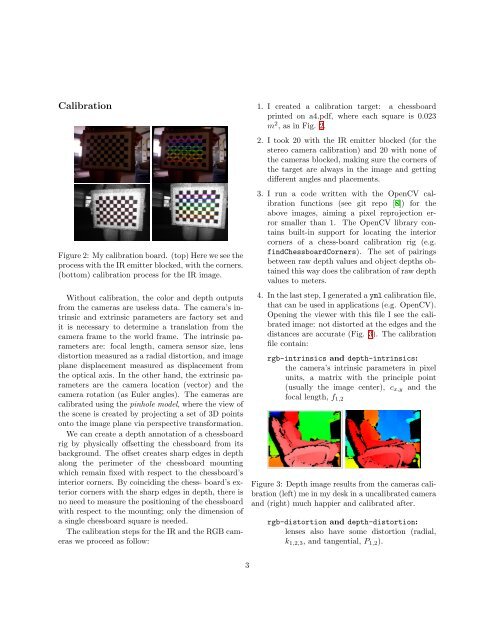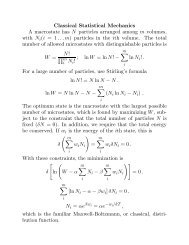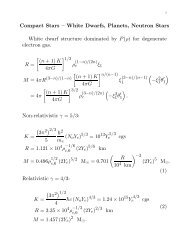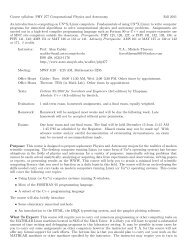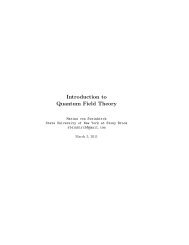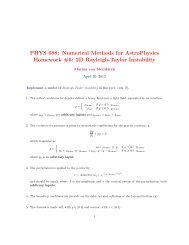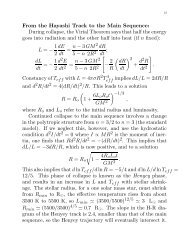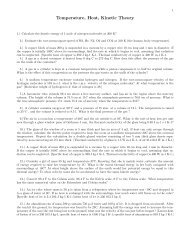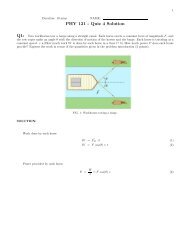how to get started in Linux with the Microsoft Kinect - Stony Brook ...
how to get started in Linux with the Microsoft Kinect - Stony Brook ...
how to get started in Linux with the Microsoft Kinect - Stony Brook ...
You also want an ePaper? Increase the reach of your titles
YUMPU automatically turns print PDFs into web optimized ePapers that Google loves.
Calibration<br />
Figure 2: My calibration board. (<strong>to</strong>p) Here we see <strong>the</strong><br />
process <strong>with</strong> <strong>the</strong> IR emitter blocked, <strong>with</strong> <strong>the</strong> corners.<br />
(bot<strong>to</strong>m) calibration process for <strong>the</strong> IR image.<br />
Without calibration, <strong>the</strong> color and depth outputs<br />
from <strong>the</strong> cameras are useless data. The camera’s <strong>in</strong>tr<strong>in</strong>sic<br />
and extr<strong>in</strong>sic parameters are fac<strong>to</strong>ry set and<br />
it is necessary <strong>to</strong> determ<strong>in</strong>e a translation from <strong>the</strong><br />
camera frame <strong>to</strong> <strong>the</strong> world frame. The <strong>in</strong>tr<strong>in</strong>sic parameters<br />
are: focal length, camera sensor size, lens<br />
dis<strong>to</strong>rtion measured as a radial dis<strong>to</strong>rtion, and image<br />
plane displacement measured as displacement from<br />
<strong>the</strong> optical axis. In <strong>the</strong> o<strong>the</strong>r hand, <strong>the</strong> extr<strong>in</strong>sic parameters<br />
are <strong>the</strong> camera location (vec<strong>to</strong>r) and <strong>the</strong><br />
camera rotation (as Euler angles). The cameras are<br />
calibrated us<strong>in</strong>g <strong>the</strong> p<strong>in</strong>hole model, where <strong>the</strong> view of<br />
<strong>the</strong> scene is created by project<strong>in</strong>g a set of 3D po<strong>in</strong>ts<br />
on<strong>to</strong> <strong>the</strong> image plane via perspective transformation.<br />
We can create a depth annotation of a chessboard<br />
rig by physically offsett<strong>in</strong>g <strong>the</strong> chessboard from its<br />
background. The offset creates sharp edges <strong>in</strong> depth<br />
along <strong>the</strong> perimeter of <strong>the</strong> chessboard mount<strong>in</strong>g<br />
which rema<strong>in</strong> fixed <strong>with</strong> respect <strong>to</strong> <strong>the</strong> chessboard’s<br />
<strong>in</strong>terior corners. By co<strong>in</strong>cid<strong>in</strong>g <strong>the</strong> chess- board’s exterior<br />
corners <strong>with</strong> <strong>the</strong> sharp edges <strong>in</strong> depth, <strong>the</strong>re is<br />
no need <strong>to</strong> measure <strong>the</strong> position<strong>in</strong>g of <strong>the</strong> chessboard<br />
<strong>with</strong> respect <strong>to</strong> <strong>the</strong> mount<strong>in</strong>g; only <strong>the</strong> dimension of<br />
a s<strong>in</strong>gle chessboard square is needed.<br />
The calibration steps for <strong>the</strong> IR and <strong>the</strong> RGB cameras<br />
we proceed as follow:<br />
1. I created a calibration tar<strong>get</strong>: a chessboard<br />
pr<strong>in</strong>ted on a4.pdf, where each square is 0.023<br />
m 2 , as <strong>in</strong> Fig. 2.<br />
2. I <strong>to</strong>ok 20 <strong>with</strong> <strong>the</strong> IR emitter blocked (for <strong>the</strong><br />
stereo camera calibration) and 20 <strong>with</strong> none of<br />
<strong>the</strong> cameras blocked, mak<strong>in</strong>g sure <strong>the</strong> corners of<br />
<strong>the</strong> tar<strong>get</strong> are always <strong>in</strong> <strong>the</strong> image and <strong>get</strong>t<strong>in</strong>g<br />
different angles and placements.<br />
3. I run a code written <strong>with</strong> <strong>the</strong> OpenCV calibration<br />
functions (see git repo [8]) for <strong>the</strong><br />
above images, aim<strong>in</strong>g a pixel reprojection error<br />
smaller than 1. The OpenCV library conta<strong>in</strong>s<br />
built-<strong>in</strong> support for locat<strong>in</strong>g <strong>the</strong> <strong>in</strong>terior<br />
corners of a chess-board calibration rig (e.g.<br />
f<strong>in</strong>dChessboardCorners). The set of pair<strong>in</strong>gs<br />
between raw depth values and object depths obta<strong>in</strong>ed<br />
this way does <strong>the</strong> calibration of raw depth<br />
values <strong>to</strong> meters.<br />
4. In <strong>the</strong> last step, I generated a yml calibration file,<br />
that can be used <strong>in</strong> applications (e.g. OpenCV).<br />
Open<strong>in</strong>g <strong>the</strong> viewer <strong>with</strong> this file I see <strong>the</strong> calibrated<br />
image: not dis<strong>to</strong>rted at <strong>the</strong> edges and <strong>the</strong><br />
distances are accurate (Fig. 3). The calibration<br />
file conta<strong>in</strong>:<br />
rgb-<strong>in</strong>tr<strong>in</strong>sics and depth-<strong>in</strong>tr<strong>in</strong>sics:<br />
<strong>the</strong> camera’s <strong>in</strong>tr<strong>in</strong>sic parameters <strong>in</strong> pixel<br />
units, a matrix <strong>with</strong> <strong>the</strong> pr<strong>in</strong>ciple po<strong>in</strong>t<br />
(usually <strong>the</strong> image center), c x,y and <strong>the</strong><br />
focal length, f 1,2<br />
Figure 3: Depth image results from <strong>the</strong> cameras calibration<br />
(left) me <strong>in</strong> my desk <strong>in</strong> a uncalibrated camera<br />
and (right) much happier and calibrated after.<br />
rgb-dis<strong>to</strong>rtion and depth-dis<strong>to</strong>rtion:<br />
lenses also have some dis<strong>to</strong>rtion (radial,<br />
k 1,2,3 , and tangential, P 1,2 ).<br />
3


